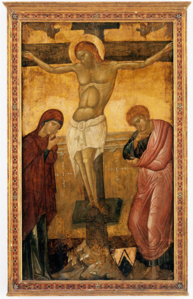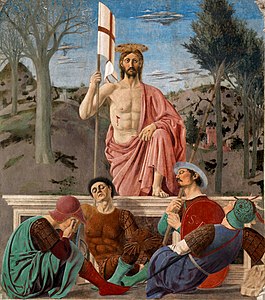
A monogram is a motif made by overlapping or combining two or more letters or other graphemes to form one symbol. Monograms are often made by combining the initials of an individual or a company, used as recognizable symbols or logos. A series of uncombined initials is properly referred to as a cypher and is not a monogram.

A Christogram is a monogram or combination of letters that forms an abbreviation for the name of Jesus Christ, traditionally used as a religious symbol within the Christian Church.

The tau cross is a T-shaped cross, sometimes with all three ends of the cross expanded. It is called a “tau cross” because it is shaped like the Greek letter tau, which in its upper-case form has the same appearance as Latin letter T.
Jesus is a masculine given name derived from Iēsous the Ancient Greek form of the Hebrew name Yeshua (ישוע). As its roots lie in the name Isho in Aramaic and Yeshua in Hebrew, it is etymologically related to another biblical name, Joshua.

Christian symbolism is the use of symbols, including archetypes, acts, artwork or events, by Christianity. It invests objects or actions with an inner meaning expressing Christian ideas.

The IX monogram or XI monogram is a type of early Christian monogram looking like the spokes of a wheel, sometimes within a circle.
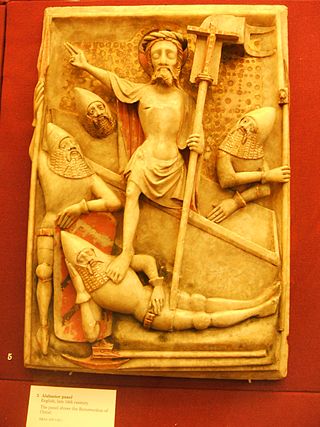
The resurrection of Jesus has long been central to Christian faith and Christian art, whether as a single scene or as part of a cycle of the Life of Christ. In the teachings of the traditional Christian churches, the sacraments derive their saving power from the passion and resurrection of Christ, upon which the salvation of the world entirely depends. The redemptive value of the resurrection has been expressed through Christian art, as well as being expressed in theological writings.

Andreas Ritzos also known as (Andreas Rico, Ricio or Rizo) was a Greek icon painter from Crete. Ritzos is considered one of the founding fathers of the Cretan School. He was affiliated with Angelos Akotantos. Most of his work stylistically follows the traditional maniera greca. His children, grandchildren, and great-grandchildren were also painters. He was one of the most influential painters of the Cretan School along with Andreas Pavias and Angelos Akotantos. He influenced the works of Georgios Klontzas, Nikolaos Tzafouris, Theophanes the Cretan, Michael Damaskinos and El Greco. According to the Institute for Neohellenic Research, sixty of his paintings have survived.

Andreas Pavias was a Greek painter and educator, one of the founding fathers of the Cretan School. His works could be found in churches and private collections throughout Italy and Greece, where they influenced countless artists. Seven of these paintings survive today, six bearing Pavias's signature. The most famous of the group is a Crucifixion.

Christ Bearing the Cross is a painting in tempera attributed to the Greek painter Nikolaos Tzafouris. Tzafouris is considered one of the founding members of the Cretan School along with Andreas Ritzos, Andreas Pavias, and Angelos Akotantos. He was influenced by Angelos Akotantos. According to the Institute of Neohellenic Research, thirteen paintings are attributed to Tzafouris. Active between 1480 and 1501, Tzafouris had a workshop in Heraklion, where he painted religious themes for local churches. His most notable works are the Madre della Consolazione and Christ Bearing the Cross.

In Thee Rejoiceth also known as Epi Si Harri is a tempera and gold leaf painting by Georgios Klontzas. The painting is a tribute to the Virgin Mary. Klontzas was active on the island of Crete during the second half of the 16th century. He was a member of the Cretan School. He was one of the most prolific Greek painters of the 16th century. Most of his works were copied by other artists. The In Thee Rejoiceth painting was copied by countless Greek and Italian painters. Theodore Poulakis created a version in the 17 century that is very similar to Klontzas's In Thee Rejoiceth. Franghias Kavertzas also painted a similar theme. He called his painting In You Rejoices. Leos Moskos also created his version of the popular painting. The Klontzas painting is currently at the Hellenic Institute of Byzantine and Post-Byzantine Studies Museum in Venice.
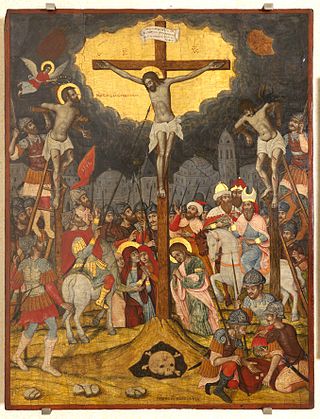
The Crucifixion is an egg tempera painting created by Ioannis Moskos. Moskos was a Greek painter originally from Crete. He migrated to Venice. Two other painters named Moskos were active during the same period. Their names were Elias Moskos and Leos Moskos. Leos and Ioannis were both in Venice during the same period. Ioannis was a member of the Late Cretan School. He was active from 1650 to 1721. Forty-four of his paintings survived.

Christ Enthroned is a tempera icon by Emmanuel Tzanes, a Greek painter of the Late Cretan School. It is currently at the Byzantine & Christian Museum in Athens.

Madonna of Constantinople is a tempera painting created by Greek painter Angelos Pitzamanos. Angelo was from the island of Crete. He was active from 1482 to 1535. His teacher was famous painter Andreas Pavias. Angelo finished commissions with his brother Donatus Pitzamanos. Eleven remaining works are attributed to Angelo. He signed most of his works in Latin, his signature poem was Angelus Bizamanus the Greek painter from Crete.
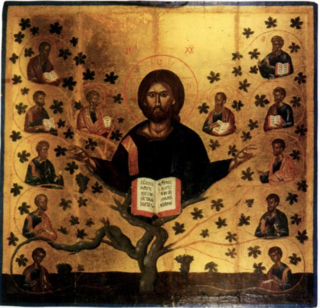
Christ the Vine is a tempera painting created by Greek painter Angelos. Angelos was active from 1425 to 1457. He was a teacher and protopsaltis. His students included some of the most famous painters of the early Cretan Renaissance. Andreas Pavias and Andreas Ritzos were his students and were heavily influenced by his style. Forty-nine of his works survived. Angelo’s Christ the Vine was one of his most important works.

The Virgin Glykofilousa with the Akathist Hymn is a tempera painting created by Greek painter Stephano Tzangarola. The work is a symbol of the craftsmanship of the Heptanese School and the evolution of Greek painting from the Byzantine style to the Cretan Renaissance style. Tzangarola was originally from Crete and migrated to Corfu. The Ionian Islands became the artistic center of the Greek world. He was active from 1675 to 1710 during the Greek Baroque period and Rococo. Twenty-two of his works survived. His student was famous Greek painter and Archpriest Andreas Karantinos.

Lamentation of Christ is an oil painting created by Greek painter Nikolaos Kantounis. He was a painter and teacher. He was a priest. His teachers were famous painters Ioannis Korais and Nikolaos Koutouzis He was a representative of the Heptanese School. His artwork was created during the Neoclassical and Romantic periods in Greek art. He was active on the island of Zakynthos from 1782–1834. He was one of the earliest members of the modern Greek art period. Over 164 of his paintings have survived. He is known for painting many portraits. He was a member of the secret organization for Greek Independence called the Filiki Eteria. Towards the end of his life he was honored with the rank of Grand Sakellarios.
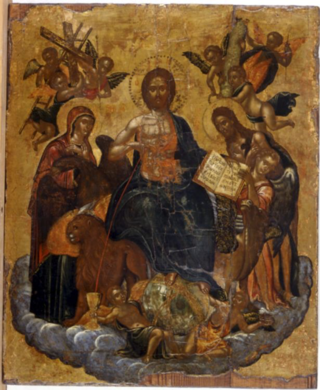
Tribute to the Eucharist was a painting made of egg tempera and gold leaf on a wood panel. The portable icon is attributed to Greek painter Michael Damaskinos. Damaskino's existing catalog features over 100 known works. He was a member of the Cretan school of painting. He was from the island of Crete. His contemporaries were Georgios Klontzas and El Greco. Damaskinos traveled all over Italy for over twenty years. He spent a significant amount of time in Venice. He adopted Italian mannerisms. He applied these new attributes to his paintings. He was friends with sculptor Alessandro Vittoria. He had a collection of drawings obtained from other Italian artists. Namely the Mannerist Parmigianino. He was also exposed to the magnificent works of Italian painter Raphael.

The Dormition and Assumption of the Virgin is a tempera painting created by Elias Moskos. Moskos was a representative of the Late Cretan School and the Heptanese School. He migrated to Zakinthos from Crete. He was originally from the city of Rethymno. He participated in the transition of Greek painting from the Cretan School to the more refined Heptanese School of the Ionian islands. He also taught painting. His activity was from 1645 to 1687. He was active on the islands of Crete, Zakynthos, and Kefalonia. He was heavily involved with church committees. Church committees commissioned paintings. Half of his works were signed fifty-two of his works survived.

The Incredulity of Saint Thomas is a tempera painting created by Greek painter Emmanuel Tzanes. Tzanes features a catalog of artwork numbering over one hundred works. He was one of the most prolific artists of the 1600s painting in Crete, Corfu, and Venice. His two brothers Marinos Tzanes and Konstantinos Tzanes were also famous painters but Marinos is more well known for his famous poem The Cretan War Ο Κρητικός Πόλεμος. All three artists were members of the Late Cretan School and early Heptanese School (painting) they were known for participating in the movement that integrated Flemish engravings into the Greek and Italian art world.

